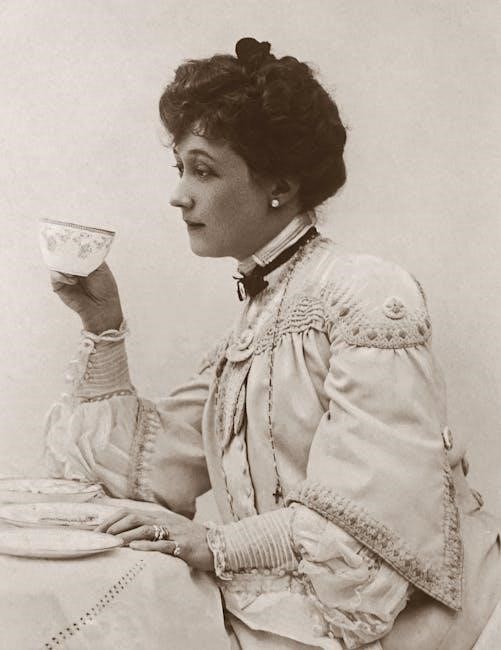Understanding communication styles is key to improving interactions. The 4 communication styles quiz helps identify strengths and areas for growth‚ fostering better personal and professional relationships through self-awareness.
Overview of the 4 Communication Styles Quiz
The 4 Communication Styles Quiz is a self-assessment tool designed to help individuals identify their dominant communication style among four categories: Direct‚ Analytical‚ Relational‚ and Inspirational. This quiz typically consists of a series of multiple-choice questions that evaluate how individuals perceive and express information‚ as well as how they interact with others. It is a popular resource for personal and professional development‚ offering insights into strengths and areas for improvement. The quiz is often used in workplace training‚ team-building exercises‚ and educational settings to foster better collaboration and understanding. By completing the quiz‚ participants gain a clearer understanding of their communication preferences and how they align with the four distinct styles. This awareness is the first step toward enhancing interpersonal skills and improving relationships in both personal and professional contexts.
Importance of Understanding Communication Styles
Understanding communication styles is essential for fostering effective interactions in both personal and professional settings. Recognizing how individuals convey and interpret information helps tailor communication approaches to meet others’ needs‚ enhancing collaboration and relationship-building. Misunderstandings and conflicts often arise from differences in communication styles‚ making it crucial to identify and adapt to these variations. In professional environments‚ this awareness can improve leadership‚ teamwork‚ and client interactions. By understanding communication styles‚ individuals can become more empathetic and adaptable‚ fostering mutual respect and trust. This knowledge not only strengthens personal connections but also contributes to a more harmonious and productive work culture. Ultimately‚ understanding communication styles empowers individuals to navigate diverse social and professional landscapes with greater ease and effectiveness‚ leading to more meaningful interactions and successful outcomes.
The Four Communication Styles
The four communication styles—Direct‚ Analytical‚ Relational‚ and Inspirational—offer a framework for understanding individual preferences in conveying and interpreting information‚ enhancing personal and professional interactions effectively.
Direct Communication Style
The Direct Communication Style is characterized by clarity‚ straightforwardness‚ and efficiency. Individuals with this style prioritize clear and concise messaging‚ avoiding unnecessary details. They value time and focus on the main points‚ often preferring quick decisions and actionable outcomes. This style is ideal for situations requiring swift problem-solving and transparent feedback. However‚ it may sometimes come across as abrupt or overly blunt‚ potentially leading to misunderstandings if others perceive it as lacking empathy. Despite this‚ the Direct style fosters productivity and ensures that goals remain the primary focus. It is particularly effective in professional settings where clarity and decisiveness are crucial. By understanding this style‚ individuals can adapt their approach to enhance collaboration and achieve desired results more effectively.

Analytical Communication Style
The Analytical Communication Style emphasizes logic‚ data‚ and detailed analysis. Individuals with this style approach conversations methodically‚ relying on facts and evidence to support their points. They thrive in environments where decisions are based on thorough research and objective criteria. This style is highly effective in technical or problem-solving contexts‚ where precision and accuracy are paramount. However‚ it may sometimes lead to overcomplicating simple issues or delaying decisions due to an excessive focus on details. Analytical communicators value expertise and are often sought out for their ability to provide well-reasoned solutions. By leveraging their strengths‚ they can ensure that decisions are informed and robust‚ though they may need to balance their approach to accommodate more intuitive or creative perspectives in certain situations.
Relational Communication Style
The Relational Communication Style focuses on building connections and fostering harmony. Individuals with this style prioritize empathy‚ active listening‚ and understanding others’ emotions. They excel in creating trust and rapport‚ making them natural mediators and team players. This style is particularly effective in collaborative environments and personal relationships‚ where mutual understanding is key. Relational communicators often seek consensus and value interpersonal dynamics‚ which can enhance group cohesion. However‚ their emphasis on harmony may sometimes lead to avoiding conflict or difficult decisions. By nurturing relationships and balancing emotional intelligence with clear communication‚ relational communicators can create supportive and inclusive environments. Their ability to connect on a personal level makes them invaluable in roles requiring strong interpersonal skills and conflict resolution.
Inspirational Communication Style
The Inspirational Communication Style is characterized by its focus on motivating and energizing others. Individuals with this style use charisma‚ enthusiasm‚ and a vision-oriented approach to inspire action and foster creativity. They excel at uplifting others‚ making them natural leaders and motivators. This style thrives in environments where innovation and passion are valued‚ such as in leadership roles or creative teams. Inspirational communicators often use storytelling and persuasive language to connect with their audience on an emotional level. However‚ their focus on big-picture ideas may sometimes lead to overlooking details. By balancing vision with practicality‚ inspirational communicators can empower others to achieve shared goals. Their ability to ignite passion and drive makes them instrumental in driving change and fostering a sense of purpose in both personal and professional settings.


Understanding Each Communication Style
Understanding each communication style involves recognizing strengths‚ weaknesses‚ and contexts where they shine. This awareness helps tailor interactions‚ fostering empathy and collaboration in personal and professional relationships effectively always.
Strengths and Weaknesses of Each Style
Each communication style has unique strengths and weaknesses. Direct communicators excel in clarity and decisiveness but may come across as blunt. Analytical styles are thorough and precise but can overanalyze‚ delaying decisions; Relational styles foster trust and harmony but may avoid conflict. Inspirational styles motivate others but can lack detail. Understanding these strengths and weaknesses helps individuals adapt their approach to different situations‚ improving overall communication effectiveness while addressing potential pitfalls. Recognizing these aspects allows for personal growth and better collaboration in both personal and professional settings.
How to Identify Your Dominant Style

Identifying your dominant communication style involves self-assessment and understanding your preferences. Start by reflecting on how you typically interact with others‚ focusing on your natural tendencies. Take the 4 communication styles quiz to gain insights into your strengths and tendencies. Consider how you handle conflict‚ share ideas‚ and build relationships. Direct communicators prioritize clarity‚ while analytical styles focus on details. Relational styles emphasize harmony‚ and inspirational styles motivate others. Pay attention to feedback from others and observe your behavior in different situations. Recognizing your dominant style helps you leverage your strengths and address areas for improvement. This self-awareness is the foundation for effective communication and personal growth‚ allowing you to adapt your approach to better connect with others in both personal and professional contexts.
The Role of Context in Communication Styles
Context plays a crucial role in shaping communication styles‚ as different situations demand varied approaches. Understanding the setting‚ audience‚ and purpose helps tailor your communication strategy. For instance‚ a direct style may be ideal in professional meetings‚ while a relational style fosters trust in personal relationships. Adaptability is key‚ as rigidly sticking to one style can hinder effectiveness. Recognizing the context allows you to adjust your tone‚ language‚ and approach‚ ensuring your message resonates. Ignoring context can lead to misunderstandings or disengagement. By considering these factors‚ you can navigate interactions more successfully‚ whether in the workplace or personal life. This awareness‚ combined with insights from the 4 communication styles quiz‚ empowers you to communicate more effectively across diverse scenarios.

Taking the 4 Communication Styles Quiz
Discover your communication style with a quick and insightful quiz. Identify strengths‚ areas for improvement‚ and gain tips to enhance your personal and professional interactions effectively.

Preparing for the Quiz

To get the most out of the 4 communication styles quiz‚ reflect on your past interactions and behaviors. Be honest with yourself to ensure accurate results. Review the quiz structure beforehand to understand the format and reduce anxiety. Find a quiet‚ distraction-free environment to take the quiz‚ allowing you to focus on your responses. Consider jotting down key situations or experiences that highlight your communication tendencies. This preparation will help you identify your dominant style and gain actionable insights. Remember‚ the goal is self-awareness and growth‚ so approach the quiz with an open mind. By preparing thoughtfully‚ you’ll be better equipped to interpret your results and apply the knowledge effectively;
Interpreting Your Quiz Results
Once you complete the 4 communication styles quiz‚ carefully review your results to understand your dominant style. Each style—Direct‚ Analytical‚ Relational‚ or Inspirational—comes with unique strengths and weaknesses. Pay attention to how your style aligns with your professional and personal interactions. Consider how your tendencies might impact others and identify areas for improvement. Reflect on specific scenarios where your style has been effective or challenging. Use the insights to adjust your communication approach in various contexts; Remember‚ understanding your style is the first step toward enhancing your relationships and achieving your goals. By interpreting your results thoughtfully‚ you can leverage your strengths and work on developing a more balanced communication approach.
Common Mistakes to Avoid During the Quiz

When taking the 4 communication styles quiz‚ avoid rushing through the questions without carefully reading them. Ensure you understand each statement before selecting an answer. Another common mistake is overthinking or second-guessing your responses. Be honest and choose the option that best reflects your natural behavior. Avoid trying to fit into a perceived ideal style‚ as this can lead to inaccurate results. Do not skip questions‚ as this may affect the overall assessment. Additionally‚ minimize distractions while taking the quiz to ensure your answers are thoughtful and genuine. By being mindful of these pitfalls‚ you can obtain a more accurate and meaningful outcome‚ helping you better understand your communication style and how to improve it.
Applying the Knowledge
Applying the insights from the 4 communication styles quiz can significantly enhance personal and professional interactions. By understanding your style‚ you can adapt your approach to improve relationships and collaboration effectively.
Improving Communication Skills Based on Quiz Results
Understanding your communication style through the quiz provides a foundation for growth. Recognizing your strengths and weaknesses allows you to adapt your approach to different situations. For instance‚ if you identify as a direct communicator‚ practice active listening to better engage with relational or inspirational styles. Conversely‚ analytical communicators can work on expressing ideas more concisely. Tailoring your communication to your audience fosters deeper connections and collaboration. Regular self-reflection and feedback from others can further refine your skills. By addressing gaps and leveraging your strengths‚ you can become a more versatile and effective communicator‚ enhancing both personal and professional relationships. Consistent practice and mindfulness in interactions will lead to meaningful improvements over time.
Enhancing Workplace Communication
Understanding the 4 communication styles is crucial for fostering a collaborative work environment. By recognizing the dominant styles of team members‚ leaders can tailor their approach to ensure clarity and alignment. Direct communicators thrive on clear instructions‚ while analytical individuals benefit from data-driven discussions. Relational styles value trust and rapport‚ and inspirational communicators respond well to vision and motivation. Encouraging diversity in communication styles promotes innovation and problem-solving. Regular team-building activities and open forums can help bridge gaps between styles. Leveraging these insights allows organizations to create a culture of empathy and understanding‚ leading to increased productivity and stronger workplace relationships. By addressing communication preferences‚ businesses can unlock the full potential of their teams and drive success.
Using Communication Styles in Personal Relationships
Recognizing communication styles can significantly enhance personal relationships by fostering understanding and empathy. Direct communicators value clarity and straightforwardness‚ while analytical individuals prefer detailed discussions. Relational styles focus on emotional connections‚ and inspirational communicators thrive on shared visions. By identifying these tendencies‚ partners can adapt their approach to meet each other’s needs. For instance‚ a direct communicator can learn to be more patient with a relational partner’s need for emotional expression. Similarly‚ an inspirational communicator can encourage an analytical partner by providing logical reasoning. Understanding these dynamics helps reduce misunderstandings and strengthens bonds. The 4 communication styles quiz offers insights to navigate these interactions effectively‚ promoting harmony and mutual respect in personal connections. By embracing these differences‚ individuals can build deeper‚ more meaningful relationships.
Understanding communication styles is crucial for effective interactions. The 4 styles quiz enhances self-awareness‚ fostering better personal and professional relationships. Apply these insights to improve your connections.
Final Thoughts on Communication Styles
Understanding and embracing the four communication styles is a powerful tool for personal and professional growth. By recognizing your dominant style and adapting to others‚ you can foster deeper connections and resolve conflicts more effectively. The insights gained from the 4 communication styles quiz can transform how you interact with colleagues‚ friends‚ and family. Remember‚ effective communication is not a one-size-fits-all approach—it’s about flexibility and empathy. Continuously refining your communication skills will lead to stronger relationships and greater success in all areas of life. Embrace this knowledge and use it to create meaningful‚ impactful interactions that leave a lasting impression.
Encouragement to Share the Quiz with Others

Sharing the 4 communication styles quiz with others can have a profound impact on their personal and professional lives. By introducing them to this tool‚ you help them gain insights into their communication preferences and improve their relationships. Encourage friends‚ family‚ and colleagues to take the quiz‚ as it fosters mutual understanding and collaboration. The more people who understand their communication styles‚ the more harmonious and effective interactions become. Share the quiz on social media‚ via email‚ or in workplace settings to spread the benefits of enhanced communication. Your initiative could inspire others to grow and connect on a deeper level‚ creating a ripple effect of positive change in their lives and yours.


































































